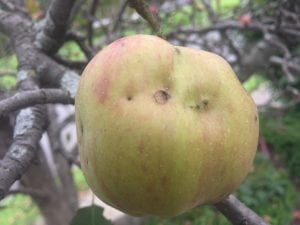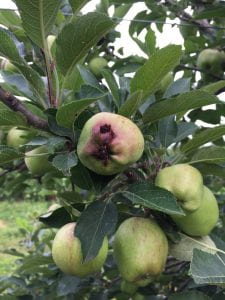Rainfall accumulations & temperature events: The start of the 2020 season began relatively mild in March with near average rainfall through April with rainfall accumulations of 3.14” in March (3.6” Ave.), and above average with 4.13” of rainfall in April (3.8” Ave.), above also above average of 5.52” in May (4.4” Ave.). June saw a below average rain events totaling 3.00” (4.4” Ave.), yet with ample rain to produce moderate levels of apple scab and significant fire blight infection in tree fruit blocks. July had relatively low weekly levels of rain providing lower than normal rainfall with accumulations of 2.44” (4.2” Ave.) with 10 days above 90F, requiring weekly irrigation and sunburn protection in UV sensitive fruiting varieties. August and September also experienced lower than normal rainfall with accumulations of 3.91” (4.2” Ave.) and 3.38” () respectively. Total rainfall for the March 1st through October 1sh growing season totaled 24.80”, lower than 2018 (26.74”) and significantly higher than 2019 (19.21 “), slightly below the seasonal average of 25.1”. Heavy rain in combination with wind events over the region were relatively lackluster in lower Ulster and Dutchess County, with no visible impact on fruit or tree architecture support systems, however, freeze events across the region on 17th-18th and 22nd-23rd May produced significant injury to the king flower during bloom and causing frost injury to developing fruitlets.
Tree phenology: Warm temperatures in early March supported early onset of bud development yet was hampered in 2020 by lingering cold temperatures beginning in late March and on-through May. The season began 7-days earlier than average, however, by petal-fall, the season was 12-days later than the 38-year phenology mid-range, 5 days earlier then the latest recorded date.
McIntosh green tip (23 March) occurred 7 days later than the 38-year historical earliest recorded date for GT at the HVRL (see McIntosh phenology). King bloom on McIntosh began on the 9th of May. Day length and predominately cool temperatures prevailed, ranging between 39.0F and 81.2F, setting the stage for a moderate bloom period lasting 10 days, on average with the mean of 9.4 days with > 80% PF in McIntosh occurring on 19th May, 12 days beyond the May 5th historical mid-range date.

Degree-day accumulations of 535.143BE and 245.750BE were near mid-range relative to the 38-year average up to PF. A moderate temperature range of 39.0F to 81.2F followed 10-days after PF.
Across the Hudson Valley, early flowering varieties in sites with well-drained soil and eastern slope suffered from significant cold temperature flower bud injury on the morning of April 17th. Assessment of flower parts indicated significant loss of viability in king flower buds, yet most farms experienced ample fruit set from lateral flowers.
There was ample sunlight and temperature (11th-14th May) for pollinators yielding strong pollination in viable flowers of mid-late varieties showing strong fruit set of lateral flowers with compromised kings. Trees required targeted yet prudent thinning for a marketable crop. Variable crop size within trees was expected and in many commercial wholesale blocks this was the case.
By 19th May, 80% of McIntosh were at petal fall, fruit had set with king fruit sized > 5 mm by 26th May.
Ample water was available during the early part of the season, with near drought conditions during June and July requiring irrigation in light soils. Low levels of bitter pit was observed at harvest using seasonal applications of calcium in mid-late pick honey crisp. Higher crop load and smaller sized fruit showing lower levels of BP.
Hail: Heavy losses from wind driven hail was experienced along the central and western slope of Marlboro ridge and valley toward the Shawangunk Ridge from New Paltz on south on 29th June at 4 PM, causing near complete loss on a number of commercial tree fruit orchards within the narrow band of the storm.
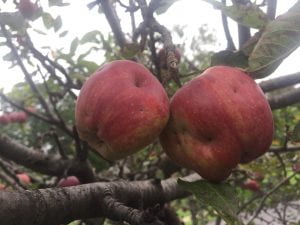
Tarnished Plant Bug (TPB) Lygus lineolaris, presence in combination with other members of the plant bug complex including Mullein Plant Bug were observed in abundance causing significant fruit injury, found to be well above the seasonal average. Orchards with historical fruit damage from TPB required timely applications for management in orchards shortly after petal fall. Significant injury occurred during the post bloom period this season as cool temperatures prior to bloom were not conducive to TPB activity. Injury from this pest was observed to be at 20.0% by the 26st of May in the UTC Ginger Gold this season with small smooth raised protuberances (MPB) and more typical inverted punctures (TPB) found on sampled fruit. Observed TPB injury during harvest fruit evaluations in Ginger Gold on 7th September in untreated plot ranged between 3.4-12.0%.
Plum Curculio (PC) Conotrachelus nenuphar damage levels were moderately high with first observation of ovipositional injury delayed due to cool temperature until the 26th June, at which time 8.0% was observed at 7 days post PF in Ginger Gold, an early commercial variety. PC ovipositional injury to fruit increased later into the season to 41.3% by the 31st May. The predictive model using 308DD50BE calculated the completion of PC migration and need for residual insecticide until 4th June using the HVRL NEWA station.
This season PC management required two applications in most orchards beginning at 80% PF based on reapplications using a 10d interval. Significant rain events occurred at the end of PF—1st cover for most mid- to late varieties. Rains after PF through 29th May (1.24” @ 10 days post PF), meant that reapplication was required on the 30th of May. A 2C June application was not required with PC hot spots addressed using board / perimeter applications in historically challenged blocks. Very light PC migration likely began during bloom when temperatures exceeded 80F on consecutive days from 18th – 19th May. In early harvest assessments prior to ‘June Drop’, damage was assessed at near 50% in untreated Ginger Gold and Red Delicious.
European apple sawfly (EAS) Hoplocampa testudinea (Klug) activity occurred in very low numbers again this season with early varieties showing a range from 0.0% to 0.5% injury in Ginger Gold cluster fruit evaluations with early harvest assessments at < 1.0%. This was the sixth year in which EAS populations were at very low fruit damage levels. Spotted Tentiform Leafminer (STLM) Phyllonorycter blancardella populations remain at very high levels in seasonal pheromone trapping with two distinct flights. Since the planting of our semi-dwarf test plots that correlate with the onset and use of the neonicotinoid class of insecticides employed in apple and reduced broad spectrum OP use, the STLM has not been observed to cause injury to foliage to a degree requiring insecticide management. Seasonal parasitism of early larval stages continue to be observed in trees with ‘soft’ insecticide programs.
San Jose scale (SJS) Quadraspidiotus perniciosus, crawler emergence was predicted to occur during the second week of June (10th – 14th June), biofix based on the 1st adult pheromone capture on the 26th of May using a 260-360 DD50BE model. Nymphs were observed in Vaseline petroleum jelly on black electrical tape on the 11th of June, 1 day after the predicted emergence date. In general, SJS scale levels were low in infested trees. The infestation means ranged from 0.5% to 3.0% injury observed in HVRL research plots on 8th July representing 1st generation infestation levels. In conventionally treated orchards, the SJS has become a major insect pest to manage in apple, requiring targeted applications for multiple generations. In 2015 we observed a 3rd generation in late September.
Lepidopteran complex: Overwintering larvae of the spotted green fruit worm (SGFW), red banded leafroller (RBLR), and obliquebanded leafroller (OBLR) during the pre-bloom period through fruit set remain a concern for most Hudson Valley and Lake Champlain pome fruit growers. The tools for use against the lepidoptera complex are diverse in mode of action, very effective, and have excellent residual activity. Relatively low levels of infestation were observed in the pre-bloom and early season leafroller complex with harvest ratings for LR injury ranging between 0.3-1.5% injury to fruit on 5th June and 4.3-6.9% injury at harvest of Ginger Gold on 7th August.
Codling Moth (CM) Cydia pomomella, 1st generation sustained adult flight occurred on 15th May with first hatch / larval emergence predicted for 30th May using 220 DD50BE from CM biofix. Complete hatch of 1st generation was predicted by 22nd June with frass from CM observed on 13th July at 16% in Ginger Gold UTC. The internal lepidopteran complex, lesser apple worm (LAW), oriental fruit moth (OFM), and codling moth (CM), showed relatively low levels of damage to apple, with frass produced by the internal lepidopteran complex appearing during mid-late July.
The 2nd generation adult emergence followed by sustained catch for the CM biofix occurred on 29th of June with management for larval emergence prediction using 250 DD50BE to occur on July 8th.
Damage from 1st and 2nd generation CM evaluated at harvest on untreated Ginger Gold showed 8.3% injured fruit.

Obliquebanded leafroller (OBLR), Choristoneura rosaceana (Harris) monitoring and management by tree fruit growers continues to be a high priority, albeit significantly lower levels of fruit injury is attributed to the leafroller complex in fruit pack-out assessments. By targeting up to three seasonal application windows, employing a single mode of action for each period, growers can achieve successful management of OBLR larvae and reduce the risk for development of insecticide resistance.
Recommended application windows include the pre-bloom through petal fall period for the overwintering generation, often using Bt during bloom, IGR’s such as Proclaim and Intrepid at petal fall; the summer generation using either Harvanta, Altacor or Delegate, and later in August applying either Delegate or Altacor, Harvanta in rotation for resistance management.
Recommendations for applications were made using insect phenology predictions for early emergence, using 340 DD50BE from biofix to manage emergence of larvae, predicted to occur on mid-June. In general, low levels of leafroller feeding were observed on developing foliage and fruitlets in spring 2020. Trap captures began on 8th June and were moderate for 1st generation OBLR averaging 4.9 moths / day during the peak periods (week of 22nd June). The 340 DD43BE emergence date of 1st summer OBLR generation was 21nd June. The 2nd generation flight began on the 27nd of July with larval emergence predicted for the 16th of August. OBLR trap numbers were very low during August at less then 0.1 adults per day.
We are seeing a trend of increasingly high levels of red banded leafroller (RBLR) with mixed populations of tufted apple bud moth (TABM) and sparganothis fruitworm (SFW) during the season, likely contributing to overall leafroller damage to foliage and fruit.
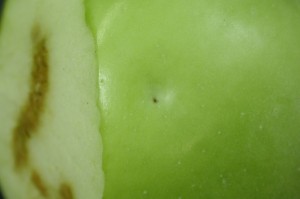
Apple maggot (AM) Rhagoletis pomonella (Walsh) emergence was very early this season (22th June) compared with first emergence on 2nd July in 2018. The threshold of 5 flies per trap per block was observed on the 29th of June. Yet AM density continued to increase throughout the season and across the region with very high emergence and subsequent trap captures peaking on 27th July at 6.0 AM flies / trap / week on through the end of August.
High populations also occurred late in the season on 17th August under ideal emergence conditions with high soil moisture for the adult fly.

Black Stem Borer (BSB) Xylosandrus germanus (Blandford) caused significant tree loss in commercial orchards during the 2019 and 2020 growing season. Fuji and Honey Crisp on dwarfing M9 rootstock in locations with well drained ripped shale outcroppings in Hudson Valley sites in Marlboro and Walden under drought conditions were found to contain BSB entry sites and rapid apple decline (RAD). These sites were under irrigation both seasons, yet proved insufficient during drought to maintain low levels of stress induced ETOH. A few sites with BSB induced RAD were observed in low lying sites with seasonal standing water. Invariably, the trees coming from nurseries have insufficient root systems on M9 & often B9, to withstand extreme wet or dry soil conditions during the first few years after planting.
European Red Mite (ERM) and Two Spotted Spider Mite (TSSM) caused considerable early season bronzing in commercial orchards during the 2020 growing season. Varieties most impacted included Red Delicious, Fuji and Honey Crisp. Repeated applications of conventional miticides made during the summer were insufficient to maintain levels of population below threshold to reduce foliar damage as sever bronzing was observed in early June. High temperatures exceeding 90F beginning in late June exacerbated egg production while providing ideal conditions for rapid generational times.
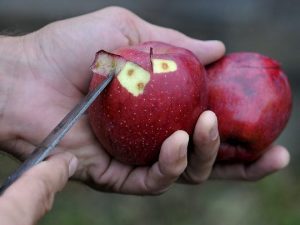
The brown marmorated stink bug (BMSB), Halyomorpha halys, has been observed throughout the southern Hudson Valley for the past 8 years with the first BMSB confirmation in NYS on December 2008. Since that time increasing populations have been documented in urban environments and present on many farms throughout the season throughout the lower to mid-Hudson Valley region. We have observed a second generation over the past few years, developing in mid-late August in HVRL voltinism studies. In 2020 we again found oviposition and newly emerging nymphs from mid-August through September.
There appears to be high levels of stink bug feeding in apple this season from both BMSB and the green stink bug, Acrosternum hilare. Both species being arboreal insects, they have been found from mid-season through harvest on pome fruit in lower to mid-Hudson Valley with increasing northern observations and fruit injury of BMSB observed in traps and higher incidence of fruit injury in WNY along the Lake Ontario fruit growing region.
BMSB has been found reproducing along the woodland edge of agricultural production systems in deciduous trees such as Sugar Maple, Acer saccharum; White Ash, Fraxinus Americana; Tree of Heaven, Ailanthus altissima; and eastern black walnut, Juglans nigra in high numbers with lower numbers observed in Staghorn Sumac, Rhus typhina, and wild grape, V. vinifera. Nymph and adult trap captures of BMSB using Tedders traps employing the USDA #10 lure, and the Plaudi stali aggregation pheromone lure, methyl (E,E,Z)-2,4,6-decatrienoate, were observed along orchard edges in Wayne, Niagara, Monroe, Ontario, Orange, Ulster, Dutchess, and Columbia Counties throughout the season. In 2020 we monitored the population throughout NYS in 12 tree fruit orchard sites, employing a trap threshold of 10 total BMSB adults per trap to recommend management timing for tree fruit production. We are presently recommending that grower’s access https://www.eddmaps.org/bmsbny/ for weekly updates on BMSB monitoring of adults and fruit injury requiring management.
Spotted wing drosophila (SWD), Drosophila suzukii, (Matsumura) (Diptera: Drosophilae) were first observed in NY late August of 2011. As in years past, EDDMaps was used to record trapping data.
Schuyler County caught the first SWD on 21st May, which is the earliest recorded capture date in NYS. In 2020 SWD were monitored in four counties throughout the lower to mid-Hudson Valley using baited Trece Pherocon traps across small fruit, grape, and tree fruit. SWD trap captures were found in Columbia County on the 22nd June, 11th June in Ulster County, on the 10th June in Suffolk County and at the HVRL on the week of the 14th of June. Populations were generally slow to build in commercial berry crops. Growers who harvested frequently and kept to a 3 to 7-day program in brambles and 10 day program in blueberry and cherry are able to maintain low infestations levels. We are presently recommending that growers access http://www.eddmaps.org/project/project.cfm?proj=9 for weekly updates on SWD monitoring of adults and fruit injury for early season management.

Major Problems/Successes this Year:
* Samurai wasp, Trissolcus japonicus, continues to be redistributed throughout the state, yet few sites of the 155 redistribution sites have shown recapture of individuals during efforts to confirm establishment. Urban citizen scientists have stated generally that home infestation of BMSB have been on the decline over the past 5-years.
* Codling moth fruit infestation continues to be a severe problem in orchards. Contributing factors include rain events reducing insecticide efficacy, lax re-application spray schedules, delayed timing during the early emergence, reduced rates, or use of less effective insecticides.
* Increasingly, wooly apple aphid, Eriosoma lanigerum, requires management in many more commercial orchards beginning in late June on-through harvest.
Unusual entomological events:
The plant bug complex caused significant injury to fruit during the early post bloom period with high levels of the plant bug complex easily observed in commercial orchards this season.


